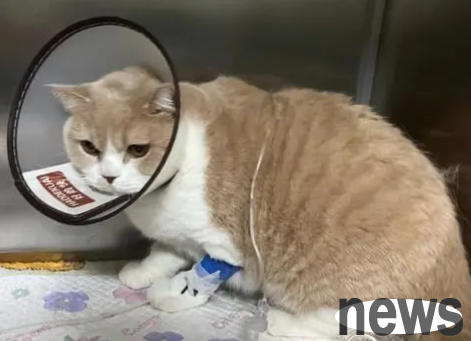In the past, we always believe that cats have hematuria, frequent urination and difficulty urination, which means stone blockage. In fact, recent studies have found that about 50 to 60% of cases are spontaneous cystitis. Spontaneous cystitis in cats is a torture for both cats and owners.

Because for cats, they will experience various painful symptoms such as frequent urination, pain in urination, hematuria, difficulty in urination. The cause of spontaneous cystitis was not clear in previous pathological studies. Now, with the development of medicine, there is also a new understanding of spontaneous cystitis in cats.

1. The causes of spontaneous cystitis in cats are currently believed to be related to the cat's living environment and urgent pressure, which in turn affects the nervous system and endocrine system. The role of the sympathetic nervous system is to release endocrine hormones such as orthoadrenaline and adrenaline, while the adrenal glands release cortisol and other steroid hormones. Distinguishing FIC is through an overexcited sympathetic nervous system or a slow endocrine response, which does not seem to affect healthy cats. Any treatment that plans to reduce sympathetic nervous system output is important to alleviate the clinical symptoms of FIC. Simply put, it means that when external stimuli are transmitted to the brain, it will cause specific physiological reactions.
There are also studies that suggest that other possible factors that cause FIC include calicivirus infection, bovine herpes virus type IV infection (BHV-4), immune problems, food types (especially dry foods with high mineral content), genetic factors or changes in the bladder epithelial cell wall. There is no difference in the incidence of FIC, both male and female cats and cats. Some scholars also point out that obese cats are prone to attack and Persian cats are prone to attack. Cats after birth control surgery seem to have a higher risk of FIC. About 50% of cats aged 1-10 have FIC, while only about 5% of cases of cats over 10 years old are FIC, so FIC is more common in young or middle-aged cats.
2. Symptoms of spontaneous cystitis in cats
Peeching anywhere is one of the most common symptoms. According to foreign studies, about 1% of cats may suffer from spontaneous cystitis, and most of the cats with spontaneous cystitis are between 1 and 10 years old. Spontaneous cystitis can occur in any breed of cats of any gender, and cats after birth control appear to have a higher incidence. Cats suffering from spontaneous cystitis usually have hematuria, frequent urination, and difficulty urination. They will exert forcefully when urinating. Some cats will scream because of pain during urination. Due to frequent urination, the hair around the genitals is dirty, so cats will often lick the hair near the genitals.
In addition to the above symptoms, the most common symptom is urinating everywhere. It was previously believed that cats urinating everywhere was just an abnormal behavior, but recent studies have found that most of them are related to spontaneous cystitis. Since these symptoms are very similar to those of urinary tract stones and urinary tract infections, it is often difficult to distinguish them based on clinical symptoms alone.
If cats with spontaneous cystitis do not experience urethral blockage, most cats still have normal spirit and appetite. They will only experience more serious symptoms when urethral obstruction occurs, such as drowsiness, poor appetite, vomiting and lack of exercise. This obstruction is usually more likely to occur in male cats, mainly because the female cat has a short urethra and is relatively wide, so it is not prone to obstruction.
3. Diagnosis
1. Physical examination
Cats will urinate frequently due to bladder pain, and the amount of urine is just a little bit. Therefore, when you go to the hospital for examination, you will mostly palpate a small or anuric bladder. If urethral obstruction occurs, abdominal palpation will cause pain, and the abdomen will be tight and hard, and a swollen and solid bladder can be palpated, which will appear weak and dehydrated in appearance.
2. Urine analysis
Improper urine samples will affect the examination results. It is recommended to use fresh urine samples obtained from bladder puncture or catheterization, and conduct an immediate test. Spontaneous cystitis may be coexisted with urolithiasis. Therefore, if a large amount of crystals is found in the urine residue, urolithiasis should be diagnosed first, and appropriate treatment and prescription feed should be given. If the symptoms continue, the possibility of spontaneous cystitis must be considered. If hematuria or proteinuria occurs in the urine sample of cats that urinate randomly, the possibility of spontaneous cystitis must be considered.
3. Most cases with whole blood count and serum biochemical
without urethral obstruction show normal test results. If obstruction occurs, postrenal azotemia, metabolic acidosis, and hyperkalemia will appear.
4, B-ultrasound examination
Some cats with FIC can see the swollen bladder wall, and thus eliminate bladder stones, tumors, prostate diseases, etc.
5. X-ray examination
excludes urethral stones and bladder stones. Special contrasting X-ray examination: abnormal bladder structure may be seen, such as the urinary diverticulum of the bladder.
6. Cystoscopy
Check the urethra and the inner lining of the bladder, and anesthesia is required to observe whether there are fine stones, polyps, and tumors, which may be difficult to evaluate in other imaging studies.
4. Treatment
You can treat cat litter box from cat litter box. You can place it in a quiet place where you are willing to go. The number of cat litter box is one more than the number of cats. Place cat litter box in different places. Clean the cat litter twice a day and replace the new cat litter every week.
